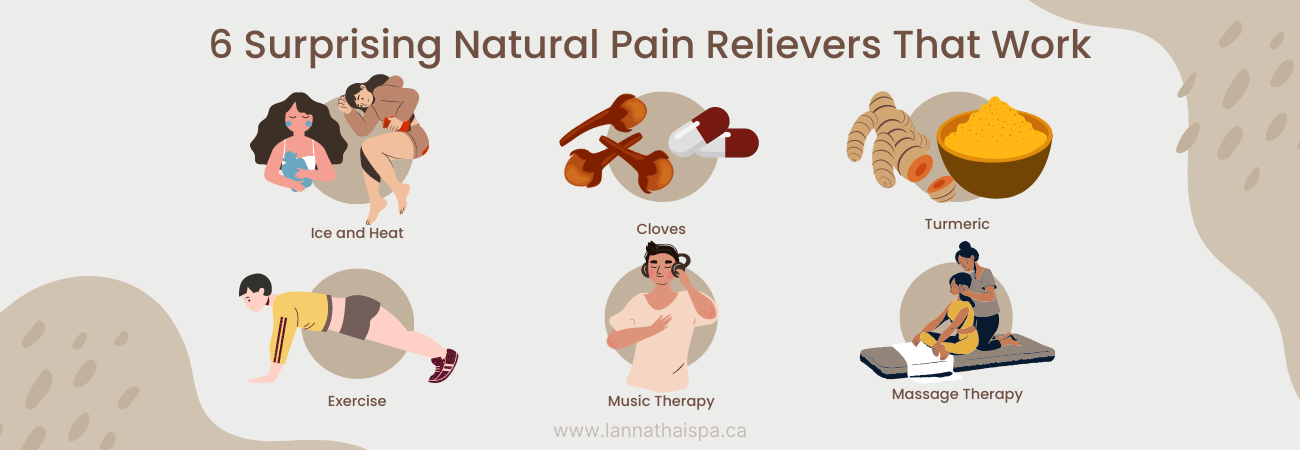Photo Credits to www.30seconds.com
Natural pain relievers should be your first choice for pain management. Most of us reach for over-the-counter medication to ease body pain immediately, but know that there are other effective options – most of which you can find or do right at home.
Whether you’re experiencing a toothache, back pain, or some form of chronic pain, don’t resort to pain medication right away unless prescribed by your doctor. You may also find relief in natural pain relievers, both in the form of herbal remedies or wellness practices.
In this article, let’s explore the best natural pain relievers to help control and reduce pain. These don’t require taking a pill or any invasive procedure.
Natural Pain Management Techniques To Try
Some conditions do require a doctor’s prescription or some pain medication. However, some simple aches and pains can be eased by simple pain management techniques. The best part? You’re reducing the risk of side effects, as OTC drugs typically contain ingredients that can be harsh on your liver, stomach, and overall health. Try these natural pain relievers instead:
Ice and Heat
Did you grow up with your mom applying an ice pack whenever you bump your head? Or perhaps a heat compress for dysmenorrhea? Both cold and heat are tried and tested methods of helping ease various types of simple aches by applying them directly to sites of pain.
However, it’s important to understand when to use cold or heat exactly when treating some injuries. Here’s a quick breakdown of when to use each.
Cold
An ice pack is usually used to help treat issues such as headaches, bleeding, and lower back pain. When you’re experiencing a strained muscle, tendon, or ligament, use an ice pack on it immediately to reduce pain and inflammation. Once the swelling has gone down, applying heat helps eases stiffness that comes with sprains and strains.
Heat
Meanwhile, heat is typically applied to provide relief from conditions like headaches, joint stiffness, and muscle stiffness. It’s also effective for helping ease arthritis. Applying heat to the affected joint helps increase blood flow, relax the muscles, and reduce stiffness, which can significantly alleviate discomfort and improve mobility.
Heat packs can be used many times and they can easily be warmed in the microwave before use. If you don’t already have a heat pack, get one because it’s going to come in handy!
When it comes to headaches, rotating heat and ice proves to be an effective pain reliever.
Cloves
You may know cloves as a spice used in various delicious meat and rice dishes such as chili, pot roast, and many pickling spice mixtures. But apart from its culinary uses, this super spice is also widely used as a pain reliever mainly due to its eugenol content. Eugenol, also called clove oil, is commonly used to treat toothaches as well as gastrointestinal and respiratory issues. Many OTC pain rubs also contain this ingredient.
You can find cloves in capsule, powder, or oil form. It’s used to help treat a wide range of conditions like headaches, nausea, cold, diarrhea, indigestion, arthritic inflammation, and fungal infection. However, it’s best to consult a medical professional first before using clove or products containing clove for pain management.
Turmeric
Another popular spice known to have pain-relieving properties is turmeric. You might know this spice as the one that gives curry its unique flavor and signature yellow color. The compound that makes it an effective pain reliever is curcumin, an antioxidant that helps the body fight free radicals that damage our cells.
Turmeric is available in supplement form and is commonly paired with piperine, a compound found in black pepper, to help increase its absorption. This super spice is known to help relieve pain from many conditions such as swelling, inflammation, indigestion and other stomach issues, ulcers, and psoriasis.
Like with any herbal supplements, it’s ideal to seek the advice of a medical professional before taking turmeric for pain relief and management. If you experience side effects like headaches, nausea, or diarrhea, stop use immediately and consult with your doctor.
Exercise
Regular physical exercise helps improve flexibility, endurance, and muscle strength. This strengthens and stabilizes joints, which in turn reduces the risk of injury and alleviates chronic pain conditions like arthritis, fibromyalgia, and lower back pain. Exercising, even gentle aerobic activities like walking, cycling, and swimming, helps improve blood flow and reduce inflammation.
In addition, physical activity promotes the release of endorphins, which are the body’s natural painkillers.
Music Therapy
Playing your favorite music will not only lift your mood, but it also helps you feel relaxed. But did you know that you can also use music for pain relief? According to a 2022 study published in Medical Xpress, listening to music can help with reducing acute pain. The study found that “Music could help people with pain relief when they have control over what music they are listening to. Additionally, people who engage with music more in their daily lives also reported a greater decrease in pain than those who don’t engage with music on a regular basis.”
Experts also believe that classical music works best, although listening to any kind of music will be helpful for managing pain.
Massage Therapy
Massage therapy is not just an indulgence – it’s a wellness practice that provides the body with numerous physical, mental, and emotional benefits. A good massage, like the ones we provide at Lanna Thai Spa, helps manage pain through several mechanisms. First, the ambiance and the massage itself calms the mind and relaxes the body, triggering the release of endorphins which are the body’s natural pain killers.
Next, the gentle manipulation of muscles and soft tissues can improve blood circulation, reducing inflammation and promoting pain relief and faster healing. Massages also release tension from the body and help lower anxiety and stress which helps decrease the perception of pain and enhances the body’s ability to cope with chronic pain conditions.

Conclusion
There are plenty of natural pain relievers that you can try instead of resorting to OTC medications right away. Depending on your doctor’s advice, choose these techniques for relieving minor aches and pains. They are effective for easing pain, making you feel good, and contributing to your overall well-being.



